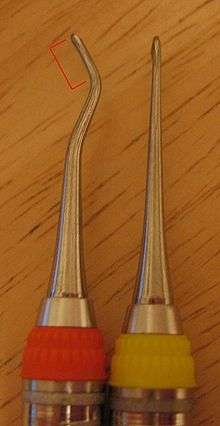Periodontal scaler


Periodontal scalers are dental instruments used in the prophylactic and periodontal care of teeth (most often human teeth), including scaling and root planing. The working ends come in a variety of shapes and sizes, but they are always narrow at the tip, so as to allow for access to narrow embrasure spaces between teeth. They differ from periodontal curettes, which possess a blunt tip.
Use
Together with periodontal curettes, periodontal scalers are used to remove calculus from teeth. While curettes are often universal in that they can be used on both supra- and sub-gingival calculus removals, scalers are restricted to supra-gingival use.[1] Use of a scaler below the gum line is likely to damage the gingiva (gums).[2]

Scalers have scraping edges on both sides of their blades and thus are fit for both mesial and distal surfaces of any tooth in the area in which they are being used.[2]
Scalers are best used when their terminal shank, namely, the last portion of the functional shank closest to the working end, is angled slightly toward the surface of the tooth.[2]
References
- ↑ Nield-Gehrig, Jill S. (2008). Fundamentals of periodontal instrumentation & advanced root instrumentation (6th ed. ed.). Philadelphia, PA [etc.]: Wolters Kluwer/Lippincott Williams & Wilkins. pp. 287, 309. ISBN 978-0-7817-6992-1.
- 1 2 3 Nield-Gehrig, Jill S. (2008). Fundamentals of periodontal instrumentation & advanced root instrumentation (6th ed. ed.). Philadelphia, PA [etc.]: Wolters Kluwer/Lippincott Williams & Wilkins. p. 288. ISBN 978-0-7817-6992-1.